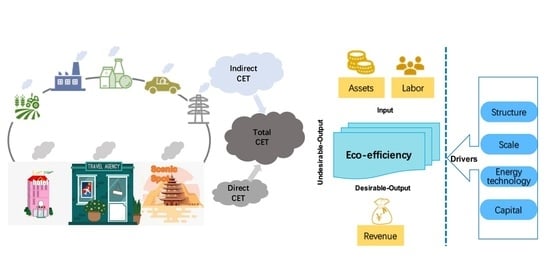Eco-Efficiency and Its Drivers in Tourism Sectors with Respect to Carbon Emissions from the Supply Chain: An Integrated EEIO and DEA Approach
Abstract
:1. Introduction
2. Literature Review and Research Framework
2.1. Literature for Carbon Emissions Evaluation of Tourism
2.2. Literature for Eco-Efficiency Evaluation of Tourism
2.3. The Research Boundary of Carbon Emissions and the Eco-Efficiency of Tourism
2.4. The Research Framework
- Step 1: To calculate the direct and total carbon emissions of the three tourism sectors through input–output analysis.
- Step 2: To analyze the main sources of indirect carbon emissions in the three tourism sectors through input–output analysis.
- Step 3: To estimate eco-efficiency with respect to direct and total carbon emissions in the three tourism sectors through the use of DEA.
- Step 4: To reveal the main drivers of the three tourism sectors through the Tobit timeseries regression model.
2.5. Study Area
3. Methods
3.1. Calculation of Direct Carbon Emissions
3.2. Calculation of the Total Carbon Emissions of Tourism Sectors Based on EEIO
3.3. Calculation of Indirect Carbon Emissions of Tourism Sectors
3.4. Assessment of the Eco-Efficiency of Tourism Sectors of Gansu Province
3.5. Input–Output Indicators for Eco-Efficiency Assessments Based on Carbon Emissions
3.6. Analysis of Drivers
3.7. Data Sources
4. Results and Discussion
4.1. The Carbon Emissions of Tourism Sectors’ in Gansu Province
4.2. The Sources of Indirect Carbon Emissions from the Supply Chain of Tourism Sectors
4.3. Analysis of the Eco-Efficiency of Tourism Sectors in Gansu
4.4. Analysis of the Drivers of Tourism Sector Eco-Efficiency in Gansu
5. Discussion
6. Conclusions
Author Contributions
Funding
Institutional Review Board Statement
Informed Consent Statement
Data Availability Statement
Acknowledgments
Conflicts of Interest
Nomenclature
| Acronyms | |||
| DEA | data envelopment analysis | XX | the input matrix of eco-efficiency |
| IOA | input–output analysis | YY | the output matrix of eco-efficiency |
| SBM | slacks-based measure of efficiency | NN | the years of eco-efficiency analysis |
| EE | eco-efficiency | z | the intermediate input/use |
| EC | the consumption of fuel | f | the final use |
| TR | the total revenue of tourist sector | l | the added value |
| CE | carbon emissions | x | the total output |
| HTI | the revenue of star-rated hotels | x’ | the total input |
| TTI | the revenue of travel agencies | η | the energy consumption coefficient |
| STI | the revenue of scenic spots | δ | the convert coefficient to standard coal |
| TTP | number of tourists served by travel agencies | μ | the carbon emissions coefficient |
| STP | number of visitors to scenic spots | xx | the input of eco-efficiency |
| HS | the proportion of star-rated hotels’ revenue | yy | the output of eco-efficiency |
| SS | the proportion of scenic spots’ revenue | s | the slack variable |
| TS | the proportion of travel agencies’ revenue | ee | eco-efficiency |
| HRI | the capital input per unit of star-rated hotels revenue | zz | the influencing indicators |
| TRI | the capital input per unit of travel agencies’ revenue | ε | disturbance term |
| SRI | the capital input per unit of scenic spots’ revenue | α | regression coefficient of the influencing factors |
| HEI | the energy input per unit of star-rated hotels revenue | ||
| TEI | the energy input per unit of travel agencies’ revenue | Subscripts | |
| SEI | the energy input per unit of scenic spots’ revenue | th | star-rated hotel |
| HDE | direct carbon emissions eco-efficiency of star-rated hotels | ta | travel agency |
| TDE | direct carbon emissions eco-efficiency of travel agencies | ts | scenic spot |
| SDE | direct carbon emissions eco-efficiency of scenic spots | ac | accommodation and catering sector |
| HTE | total carbon emissions eco-efficiency of star-rated hotels | os | other services sector |
| TTE | total carbon emissions eco-efficiency of travel agencies | i | the i th industry sector |
| STE | total carbon emissions eco-efficiency of scenic spots | j | the j th industry sector |
| PGDP | per GDP | n | the number of the industry sectors |
| THI | proportion of tertiary industry | m | the number of the regions |
| UR | proportion of urban population | r | the number of the types of fuel |
| ED | number of students in colleges and universities | k | the k th fuel |
| FR | total investment of foreign enterprises | g | the good output |
| RO | road mileage | b | the bad output |
| p | the number of the input indicators | ||
| Notations | q | the years of eco-efficiency analysis | |
| X | the total output matrix | d | the d th input indicator |
| Y | the final use matrix | r | the r th output indicator |
| A | the direct consumption coefficient matrix | λ | the intensity vector in SBM model |
| I | identity matrix | t | the t th year |
| IS | industrial sector | direct | direct carbon emissions |
| L | the value-added matrix | total | total carbon emissions |
| P | the production possibility set | control | control variables |
References
- UNWTO. Annual Report 2019; UNWTO: Madrid, Spain, 2020. [Google Scholar]
- Lee, L.C.; Wang, Y.; Zuo, J. The nexus of water-energy-food in China’s tourism industry. Resour. Conserv. Recycl. 2021, 164, 9. [Google Scholar] [CrossRef]
- Chenghu, Z.; Arif, M.; Shehzad, K.; Ahmad, M.; Oláh, J. Modeling the Dynamic Linkage between Tourism Development, Technological Innovation, Urbanization and Environmental Quality: Provincial Data Analysis of China. Int. J. Environ. Res. Public Health 2021, 18, 8456. [Google Scholar] [CrossRef] [PubMed]
- UNWTO. Recommendations for Tourism Statistics 2008; Department of Economic and Social Affairs: New York, NY, USA, 2010. [Google Scholar]
- Whittlesea, E.R.; Owen, A. Towards a low carbon future—The development and application of REAP Tourism, a destination footprint and scenario tool. J. Sustain. Tour. 2012, 20, 845–865. [Google Scholar] [CrossRef]
- Sun, Y.-Y. A framework to account for the tourism carbon footprint at island destinations. Tour. Manag. 2014, 45, 16–27. [Google Scholar] [CrossRef]
- Lenzen, M.; Sun, Y.-Y.; Faturay, F.; Ting, Y.-P.; Geschke, A.; Malik, A. The carbon footprint of global tourism. Nat. Clim. Chang. 2018, 8, 522–528, Correction in Nat. Clim. Chang. 2018, 8, 544. [Google Scholar] [CrossRef]
- Guan, D.; Wang, D.; Hallegatte, S.; Davis, S.J.; Huo, J.; Li, S.; Bai, Y.; Lei, T.; Xue, Q.; Coffman, D.; et al. Global supply-chain effects of COVID-19 control measures. Nat. Hum. Behav. 2020, 4, 577–587. [Google Scholar] [CrossRef] [PubMed]
- Sun, Y.-Y.; Higham, J. Overcoming information asymmetry in tourism carbon management: The application of a new reporting architecture to Aotearoa New Zealand. Tour. Manag. 2021, 83, 104231. [Google Scholar] [CrossRef] [PubMed]
- Sun, Y.-Y. Global Value Chains and National Tourism Carbon Competitiveness. J. Travel Res. 2018, 58, 808–823. [Google Scholar] [CrossRef]
- Matveeva, N.S.; Nazarov, V.S. Legislative Regulation Financial Statement Preparation by Micro Entities: International Experience. Financ. J. 2021, 5, 125–138. [Google Scholar] [CrossRef]
- UNWTO. Tourism and the Sustainable Development Goals—Journey to 2030; UNWTO: Madrid, Spain, 2017. [Google Scholar]
- Paiano, A.; Crovella, T.; Lagioia, G. Managing sustainable practices in cruise tourism: The assessment of carbon footprint and waste of water and beverage packaging. Tour. Manag. 2019, 77, 104016. [Google Scholar] [CrossRef]
- Sun, Y.-Y.; Drakeman, D. Measuring the carbon footprint of wine tourism and cellar door sales. J. Clean. Prod. 2020, 266, 121937. [Google Scholar] [CrossRef]
- Ehrenfeld, J.R. Eco-efficiency—Philosophy, theory, and tools. J. Ind. Ecol. 2005, 9, 6–8. [Google Scholar] [CrossRef]
- Gössling, S.; Peeters, P.; Ceron, J.-P.; Dubois, G.; Patterson, T.; Richardson, R. The eco-efficiency of tourism. Ecol. Econ. 2005, 54, 417–434. [Google Scholar] [CrossRef]
- Sun, Y.-Y.; Lin, P.-C.; Higham, J. Managing tourism emissions through optimizing the tourism demand mix: Concept and analysis. Tour. Manag. 2020, 81, 104161. [Google Scholar] [CrossRef]
- Papavasileiou, E.F.; Tzouvanas’, P. Tourism Carbon Kuznets-Curve Hypothesis: A Systematic Literature Review and a Paradigm Shift to a Corporation-Performance Perspective. J. Travel Res. 2021, 60, 896–911. [Google Scholar] [CrossRef]
- Pan, Y.; Weng, G.; Li, C.; Li, J. Coupling Coordination and Influencing Factors among Tourism Carbon Emission, Tourism Economic and Tourism Innovation. Int. J. Environ. Res. Public Health 2021, 18, 1601. [Google Scholar] [CrossRef]
- Zha, J.; Tan, T.; Yuan, W.; Yang, X.; Zhu, Y. Decomposition analysis of tourism CO2 emissions for sustainable development: A case study of China. Sustain. Dev. 2019, 28, 169–186. [Google Scholar] [CrossRef]
- Ruan, W.; Li, Y.; Zhang, S.; Liu, C.-H. Evaluation and drive mechanism of tourism ecological security based on the DPSIR-DEA model. Tour. Manag. 2019, 75, 609–625. [Google Scholar] [CrossRef]
- Zha, J.; Zhu, Y.; He, D.; Tan, T.; Yang, X. Sources of tourism growth in Mainland China: An extended data envelopment analysis-based decomposition analysis. Int. J. Tour. Res. 2020, 22, 54–70. [Google Scholar] [CrossRef]
- Zhang, J.; Zhang, Y. Assessing the low-carbon tourism in the tourism-based urban destinations. J. Clean. Prod. 2020, 276, 124303. [Google Scholar] [CrossRef]
- Robaina-Alves, M.; Moutinho, V.; Costa, R. Change in energy-related CO2 (carbon dioxide) emissions in Portuguese tourism: A decomposition analysis from 2000 to 2008. J. Clean. Prod. 2016, 111, 520–528. [Google Scholar] [CrossRef]
- Puig, R.; Kiliç, E.; Navarro, A.; Albertí, J.; Chacón, L.; Fullana-I-Palmer, P. Inventory analysis and carbon footprint of coastland-hotel services: A Spanish case study. Sci. Total Environ. 2017, 595, 244–254. [Google Scholar] [CrossRef] [PubMed]
- Lee, J.W.; Brahmasrene, T. Investigating the influence of tourism on economic growth and carbon emissions: Evidence from panel analysis of the European Union. Tour. Manag. 2013, 38, 69–76. [Google Scholar] [CrossRef]
- Bianco, V. Analysis of electricity consumption in the tourism sector. A decomposition approach. J. Clean. Prod. 2020, 248, 119286. [Google Scholar] [CrossRef]
- Katircioglu, S.T. International tourism, energy consumption, and environmental pollution: The case of Turkey. Renew. Sustain. Energy Rev. 2014, 36, 180–187. [Google Scholar] [CrossRef]
- Pereira, R.P.T.; Ribeiro, G.M.; Filimonau, V. The carbon footprint appraisal of local visitor travel in Brazil: A case of the Rio de Janeiro-São Paulo itinerary. J. Clean. Prod. 2016, 141, 256–266. [Google Scholar] [CrossRef] [Green Version]
- Cadarso, M.Á.; Gomez, N.; López, L.A.; Tobarra, M.Á. Calculating tourism’s carbon footprint: Measuring the impact of investments. J. Clean. Prod. 2016, 111, 529–537. [Google Scholar] [CrossRef]
- Yang, Y.; Li, W. The evolution of the ecological footprint and its relationship with the urban development of megacities in Western China: The case of Xi’an. J. Environ. Manag. 2019, 243, 463–471. [Google Scholar] [CrossRef] [PubMed]
- Chen, Q.; Mao, Y.; Morrison, A.M. Impacts of Environmental Regulations on Tourism Carbon Emissions. Int. J. Environ. Res. Public Health 2021, 18, 12850. [Google Scholar] [CrossRef] [PubMed]
- Wang, Z.; Yang, Y.; Wang, B. Carbon footprints and embodied CO2 transfers among provinces in China. Renew. Sustain. Energy Rev. 2018, 82, 1068–1078. [Google Scholar] [CrossRef]
- Huang, Z.; Cao, F.; Jin, C.; Yu, Z.; Huang, R. Carbon emission flow from self-driving tours and its spatial relationship with scenic spots—A traffic-related big data method. J. Clean. Prod. 2017, 142, 946–955. [Google Scholar] [CrossRef]
- Tsai, K.-T.; Lin, T.-P.; Hwang, R.-L.; Huang, Y.-J. Carbon dioxide emissions generated by energy consumption of hotels and homestay facilities in Taiwan. Tour. Manag. 2014, 42, 13–21. [Google Scholar] [CrossRef]
- Luo, F.; Becken, S.; Zhong, Y. Changing travel patterns in China and ‘carbon footprint’ implications for a domestic tourist destination. Tour. Manag. 2018, 65, 1–13. [Google Scholar] [CrossRef]
- Mi, Z.; Zheng, J.; Meng, J.; Ou, J.; Hubacek, K.; Liu, Z.; Coffman, D.; Stern, N.; Liang, S.; Wei, Y.-M. Economic development and converging household carbon footprints in China. Nat. Sustain. 2020, 3, 529–537. [Google Scholar] [CrossRef]
- Xu, Z.; Li, Y.; Chau, S.N.; Dietz, T.; Li, C.; Wan, L.; Zhang, J.; Zhang, L.; Li, Y.; Chung, M.G.; et al. Impacts of international trade on global sustainable development. Nat. Sustain. 2020, 3, 964–971. [Google Scholar] [CrossRef]
- López, L.A.; Cadarso, M.Á.; Zafrilla, J.; Arce, G. The carbon footprint of the U.S. multinationals’ foreign affiliates. Nat. Commun. 2019, 10, 1672. [Google Scholar] [CrossRef] [PubMed] [Green Version]
- Cheng, H.; Dong, S.; Li, F.; Yang, Y.; Li, S.; Li, Y. Multiregional Input-Output Analysis of Spatial-Temporal Evolution Driving Force for Carbon Emissions Embodied in Interprovincial Trade and Optimization Policies: Case Study of Northeast Industrial District in China. Environ. Sci. Technol. 2018, 52, 346–358. [Google Scholar] [CrossRef]
- Wiedmann, T.; Minx, J. Definition of Carbon Footprint. In Ecological Economics Research Trends; Pertsova, C.C., Ed.; Nova Publishers: Hauppauge, NY, USA, 2008; Volume 1, pp. 1–11. [Google Scholar]
- Berners-Lee, M.; Howard, D.C.; Moss, J.; Kaivanto, K.; Scott, W.A. Greenhouse gas footprinting for small businesses—The use of input–output data. Sci. Total Environ. 2011, 409, 883–891. [Google Scholar] [CrossRef]
- Frampton, S.C. Energy use associated with different travel choices. Tour. Manag. 2003, 24, 267–277. [Google Scholar]
- Kuo, N.-W.; Lin, C.-Y.; Chen, P.-H.; Chen, Y.-W. An inventory of the energy use and carbon dioxide emissions from island tourism based on a life cycle assessment approach. Environ. Prog. Sustain. Energy 2009, 31, 459–465. [Google Scholar] [CrossRef]
- Gamboa, M.M.; Iribarren, D.; Dufour, J. Environmental impact efficiency of natural gas combined cycle power plants: A combined life cycle assessment and dynamic data envelopment analysis approach. Sci. Total Environ. 2018, 615, 29–37. [Google Scholar] [CrossRef] [PubMed]
- AbdelAzim, A.I.; Ibrahim, A.M.; Aboul-Zahab, E.M. Development of an energy efficiency rating system for existing buildings using Analytic Hierarchy Process—The case of Egypt. Renew. Sustain. Energy Rev. 2017, 71, 414–425. [Google Scholar] [CrossRef]
- Tsaples, G.; Papathanasiou, J. Data envelopment analysis and the concept of sustainability: A review and analysis of the literature. Renew. Sustain. Energy Rev. 2020, 138, 110664. [Google Scholar] [CrossRef]
- Quintano, C.; Mazzocchi, P.; Rocca, A. Examining eco-efficiency in the port sector via non-radial data envelopment analysis and the response based procedure for detecting unit segments. J. Clean. Prod. 2020, 259, 120979. [Google Scholar] [CrossRef]
- Gössling, S.; Higham, J. The Low-Carbon Imperative: Destination Management under Urgent Climate Change. J. Travel Res. 2020, 60, 1167–1179. [Google Scholar] [CrossRef]
- Xia, B.; Dong, S.; Ba, D.; Li, Y.; Li, F.; Liu, H.; Zhao, M. Research on the Spatial Differentiation and Driving Factors of Tourism Enterprises’ Efficiency: Chinese Scenic Spots, Travel Agencies, and Hotels. Sustainability 2018, 10, 901. [Google Scholar] [CrossRef] [Green Version]
- Yang, Y.; Yao, C.; Xu, D. Ecological compensation standards of national scenic spots in western China: A case study of Taibai Mountain. Tour. Manag. 2020, 76, 103950. [Google Scholar] [CrossRef]
- Wang, L.; Zhou, X.; Lu, M.; Cui, Z. Impacts of haze weather on tourist arrivals and destination preference: Analysis based on Baidu Index of 73 scenic spots in Beijing, China. J. Clean. Prod. 2020, 273, 122887. [Google Scholar] [CrossRef]
- W. O. Economics. 2017 Travel & Tourism Economic Impact Research; W. O. Economics: Oxford, UK, 2017. [Google Scholar]
- Koiwanit, J.; Filimonau, V. Carbon footprint assessment of home-stays in Thailand Resource. Conserv. Recycl. 2021, 164, 105123. [Google Scholar] [CrossRef]
- Zhang, F.; Zhang, M.; Wang, S.; Qiang, F.; Che, Y.; Wang, J. Evaluation of the tourism climate in the Hexi Corridor of northwest China’s Gansu Province during 1980–2012. Arch. Meteorol. Geophys. Bioclimatol. Ser. B 2017, 129, 901–912. [Google Scholar] [CrossRef]
- Zhang, K.; Liu, X.; Yao, J. Spatial correlation between the agglomeration and CO2 emissions of China’s tourism industry. Resour. Sci. 2019, 41, 362–371. [Google Scholar]
- Rebolledo-Leiva, R.; Vásquez-Ibarra, L.; Entrena-Barbero, E.; Fernández, M.; Feijoo, G.; Moreira, M.T.; González-García, S. Coupling Material Flow Analysis and Network DEA for the evaluation of eco-efficiency and circularity on dairy farms. Sustain. Prod. Consump. 2022, 31, 805–817. [Google Scholar] [CrossRef]
- Li, Y.; Zuo, Z.; Xu, D.; Wei, Y. Mining Eco-Efficiency Measurement and Driving Factors Identification Based on Meta-US-SBM in Guangxi Province, China. Int. J. Environ. Res. Public Health 2021, 18, 5397. [Google Scholar] [CrossRef] [PubMed]
- Cooper, W.W.; Seiford, L.M.; Tone, K. Data Envelopment Analysis. A Comprehensive Text with Models, Applications, References and DEA-Solver Software, 2nd ed.; Springer Science + Business Media, LLC: New York, NY, USA, 2007. [Google Scholar]
- McDonald, J.F.; Moffitt, R.A. The Uses of Tobit Analysis. Rev. Econ. Stat. 1980, 62, 318–321. [Google Scholar] [CrossRef]
- Cheng, Y.; Shao, T.; Lai, H.; Shen, M.; Li, Y. Total-Factor Eco-Efficiency and Its Influencing Factors in the Yangtze River Delta Urban Agglomeration, China. Int. J. Environ. Res. Public Health 2019, 16, 3814. [Google Scholar] [CrossRef] [PubMed] [Green Version]
- Chen, Y.; Yin, G.; Liu, K. Regional differences in the industrial water use efficiency of China: The spatial spillover effect and relevant factors. Resour. Conserv. Recycl. 2021, 167, 105239. [Google Scholar] [CrossRef]
- Ren, Y.; Fang, C.; Li, G. Spatiotemporal characteristics and influential factors of eco-efficiency in Chinese prefecture-level cities: A spatial panel econometric analysis. J. Clean. Prod. 2020, 260, 120787. [Google Scholar] [CrossRef]
- Zhang, J.; Wang, S.; Yang, P.; Fan, F.; Wang, X. Analysis of Scale Factors on China’s Sustainable Development Efficiency Based on Three-Stage DEA and a Double Threshold Test. Sustainability 2020, 12, 2225. [Google Scholar] [CrossRef] [Green Version]
- Zhou, Y.; Kong, Y.; Sha, J.; Wang, H. The role of industrial structure upgrades in eco-efficiency evolution: Spatial correlation and spillover effects. Sci. Total Environ. 2019, 687, 1327–1336. [Google Scholar] [CrossRef] [PubMed]
- He, L.; Zha, J.; Loo, H.A. How to improve tourism energy efficiency to achieve sustainable tourism: Evidence from China. Curr. Issues Tour. 2020, 23, 2076–2092. [Google Scholar] [CrossRef]
- Luo, F.; Moyle, B.D.; Moyle, C.-L.J.; Zhong, Y.; Shi, S. Drivers of carbon emissions in China’s tourism industry. J. Sustain. Tour. 2020, 28, 747–770. [Google Scholar] [CrossRef]
- Hu, W.; Guo, Y.; Tian, J.; Chen, L. Eco-efficiency of centralized wastewater treatment plants in industrial parks: A slack-based data envelopment analysis. Resour. Conserv. Recycl. 2019, 141, 176–186. [Google Scholar] [CrossRef]
- Tang, M.; Li, Z.; Hu, F.; Wu, B. How does land urbanization promote urban eco-efficiency? The mediating effect of industrial structure advancement. J. Clean. Prod. 2020, 272, 122798. [Google Scholar] [CrossRef]
- Chen, W.; Ning, S.; Chen, W.; Liu, E.-N.; Wang, Y.; Zhao, M. Spatial-temporal characteristics of industrial land green efficiency in China: Evidence from prefecture-level cities. Ecol. Indic. 2020, 113, 106256. [Google Scholar] [CrossRef]
- Wang, J.; Wang, S.; Li, S.; Cai, Q.; Gao, S. Evaluating the energy-environment efficiency and its determinants in Guangdong using a slack-based measure with environmental undesirable outputs and panel data model. Sci. Total Environ. 2019, 663, 878–888. [Google Scholar] [CrossRef] [PubMed]
- Arceo, A.; Biswas, W.K.; John, M. Eco-efficiency improvement of Western Australian remote area power supply. J. Clean. Prod. 2019, 230, 820–834. [Google Scholar] [CrossRef]
- Zha, J.; Yuan, W.; Dai, J.; Tan, T.; He, L. Eco-efficiency, eco-productivity and tourism growth in China: A non-convex metafrontier DEA-based decomposition model. J. Sustain. Tour. 2020, 28, 663–685. [Google Scholar] [CrossRef]
- Meng, W.Q.; Xu, L.Y.; Hu, B.B.; Zhou, J.; Wang, Z.L. Quantifying direct and indirect carbon dioxide emissions of the Chinese tourism industry. J. Clean. Prod. 2017, 163, S401–S409, reprinted in J. Clean. Prod. 2016, 126, 586–594. [Google Scholar] [CrossRef]
- Becken, S.; Patterson, M. Measuring National Carbon Dioxide Emissions from Tourism as a Key Step Towards Achieving Sustainable Tourism. J. Sustain. Tour. 2006, 14, 323–338. [Google Scholar] [CrossRef]
- Dwyer, L.; Forsyth, P.; Spurr, R.; Hoque, S. Estimating the carbon footprint of Australian tourism. J. Sustain. Tour. 2010, 18, 355–376. [Google Scholar] [CrossRef]
- Cheng, Z.; Li, L.; Liu, J. Industrial structure, technical progress and carbon intensity in China’s provinces. Renew. Sust. Energ. Rev. 2018, 81, 2935–2946. [Google Scholar] [CrossRef]
- Zaman, K.; Shahbaz, M.; Loganathan, N.; Raza, S.A. Tourism development, energy consumption and Environmental Kuznets Curve: Trivariate analysis in the panel of developed and developing countries. Tour. Manag. 2016, 54, 275–283. [Google Scholar] [CrossRef]
- Xue, D.; Yue, L.; Ahmad, F.; Draz, M.U.; Chandio, A.A. Urban eco-efficiency and its influencing factors in Western China: Fresh evidence from Chinese cities based on the US-SBM. Ecol. Indic. 2021, 127, 107784. [Google Scholar] [CrossRef]
- Haibo, C.; Ke, D.; Fangfang, W.; Ayamba, E.C. The spatial effect of tourism economic development on regional ecological efficiency. Environ. Sci. Pollut. Res. 2020, 27, 38241–38258. [Google Scholar] [CrossRef] [PubMed]
- Lu, C.; Li, W.; Pang, M.; Xue, B.; Miao, H. Quantifying the Economy-Environment Interactions in Tourism: Case of Gansu Province, China. Sustainability 2018, 10, 711. [Google Scholar] [CrossRef] [Green Version]
- Moiseev, N.; Mikhaylov, A.; Varyash, I.; Saqib, A. Investigating the relation of GDP per capita and corruption index. Entrep. Sustain. Issues 2020, 8, 780–794. [Google Scholar] [CrossRef]
- Li, Y.; Filimonau, V.; Wang, L.-E.; Cheng, S. Tourist food consumption and its arable land requirements in a popular tourist destination. Resour. Conserv. Recycl. 2019, 153, 104587. [Google Scholar] [CrossRef]
- Yi-Ming, W.; Meng, J.; Guan, D.; Shan, Y.; Song, M.; Wei, Y.-M.; Liu, Z.; Hubacek, K. Chinese CO2 emission flows have reversed since the global financial crisis. Nat. Commun. 2017, 8, 1712. [Google Scholar] [CrossRef]
- Bushukina, V.I. Specific Features of Renewable Energy Development in the World and Russia. Financ. J. 2021, 13, 93–107. [Google Scholar] [CrossRef]
- Kranina, E.I. China on the Way to Achieving Carbon Neutrality. Financ. J. 2021, 13, 51–61. [Google Scholar] [CrossRef]

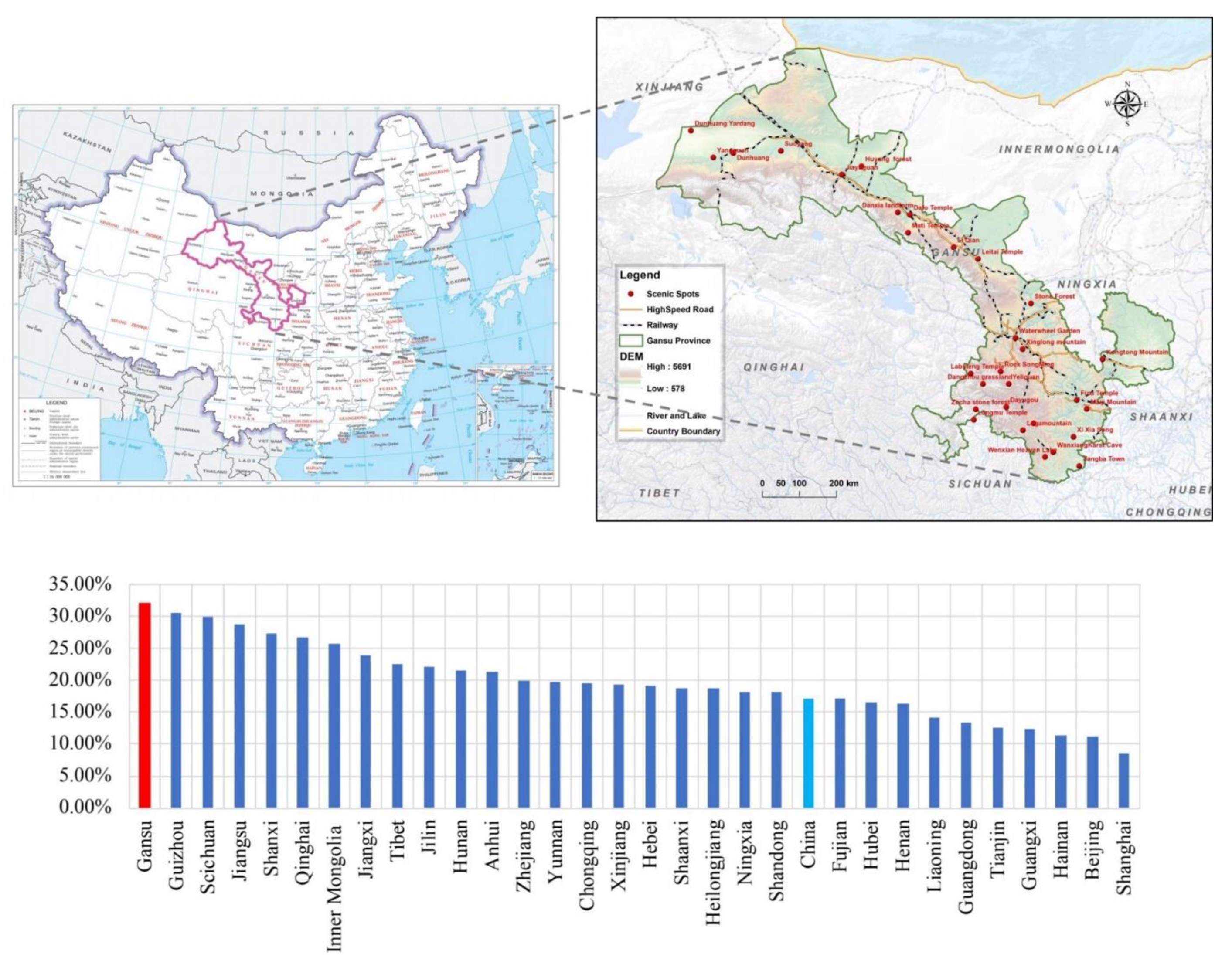
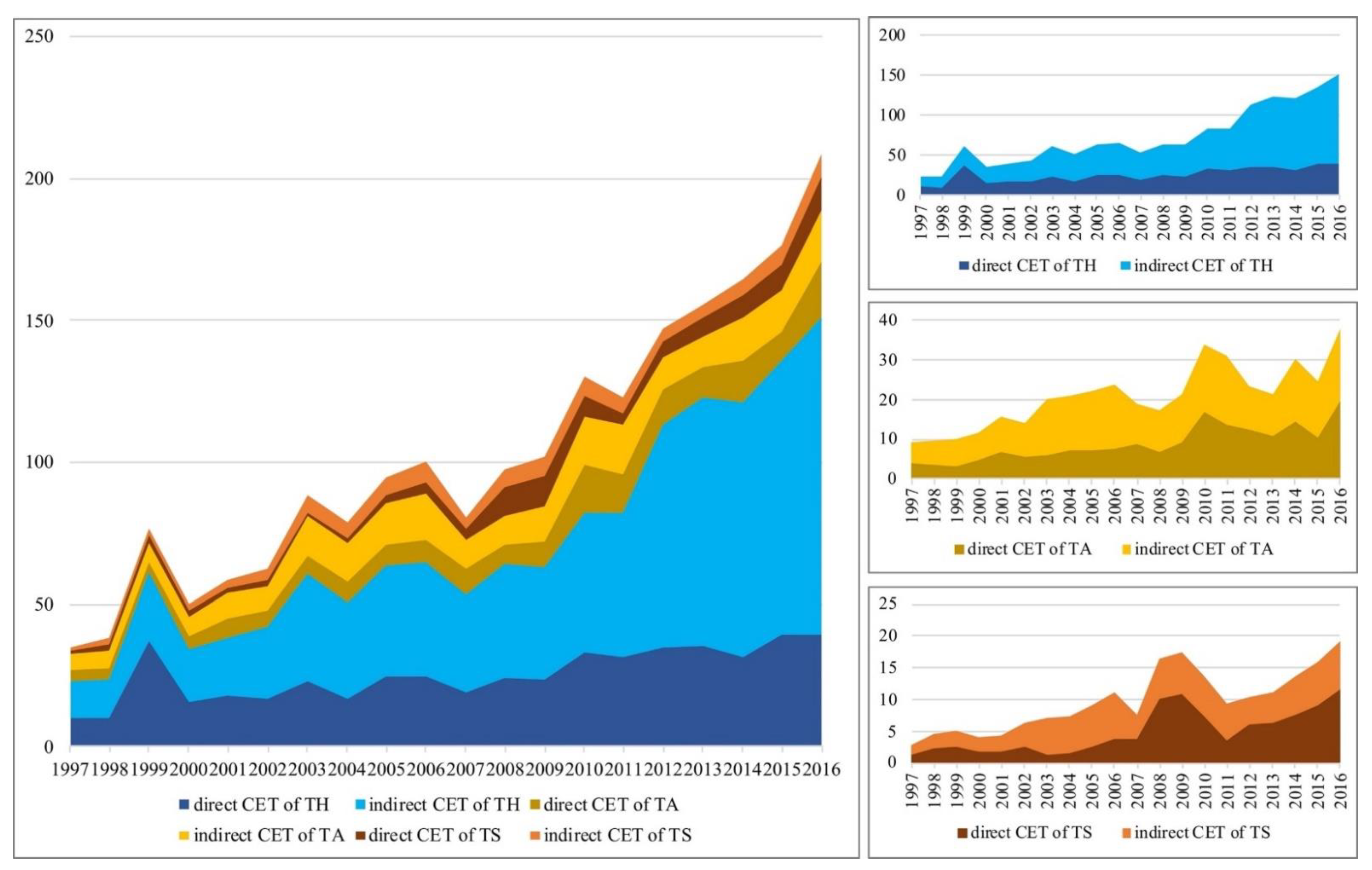
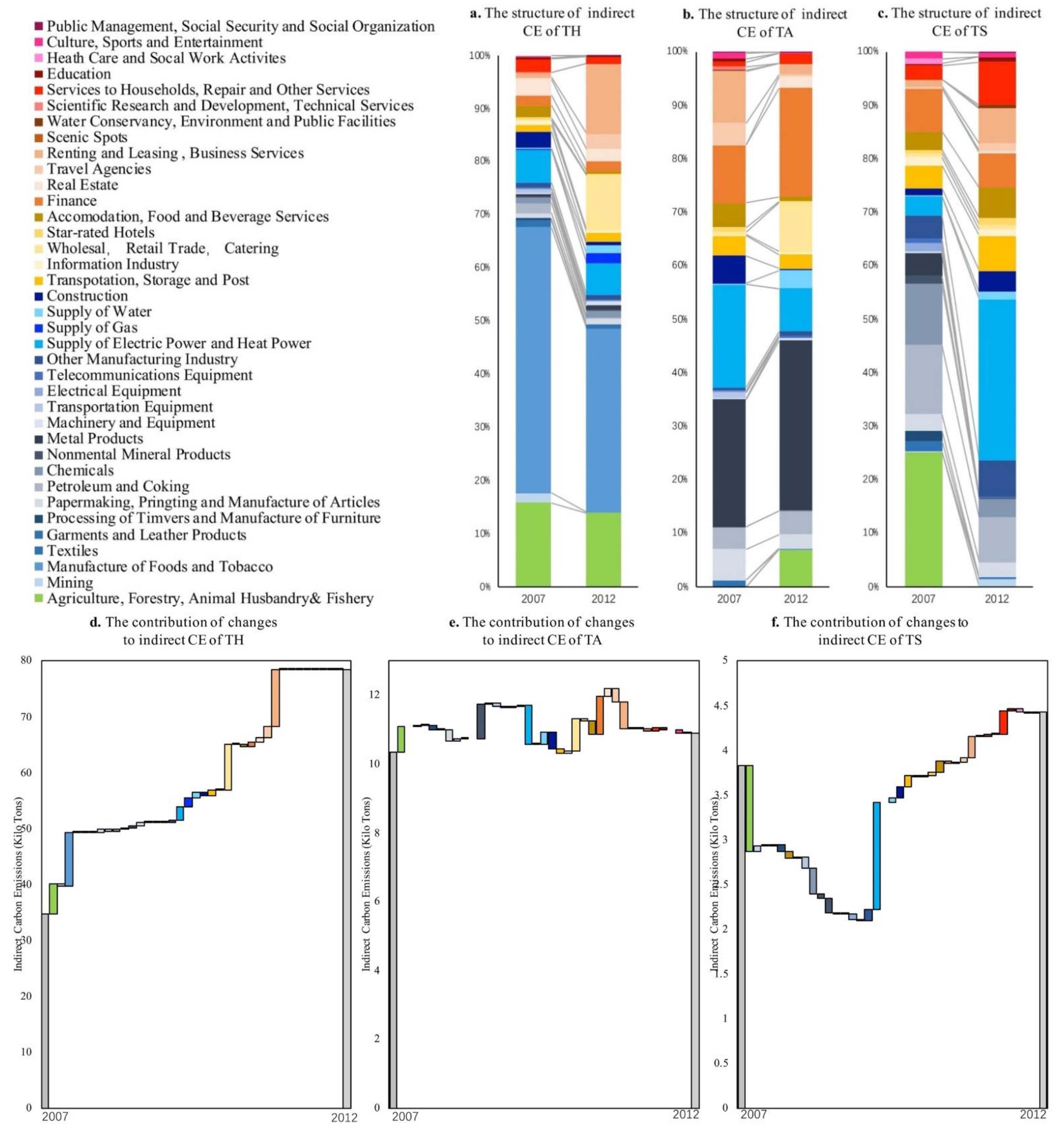
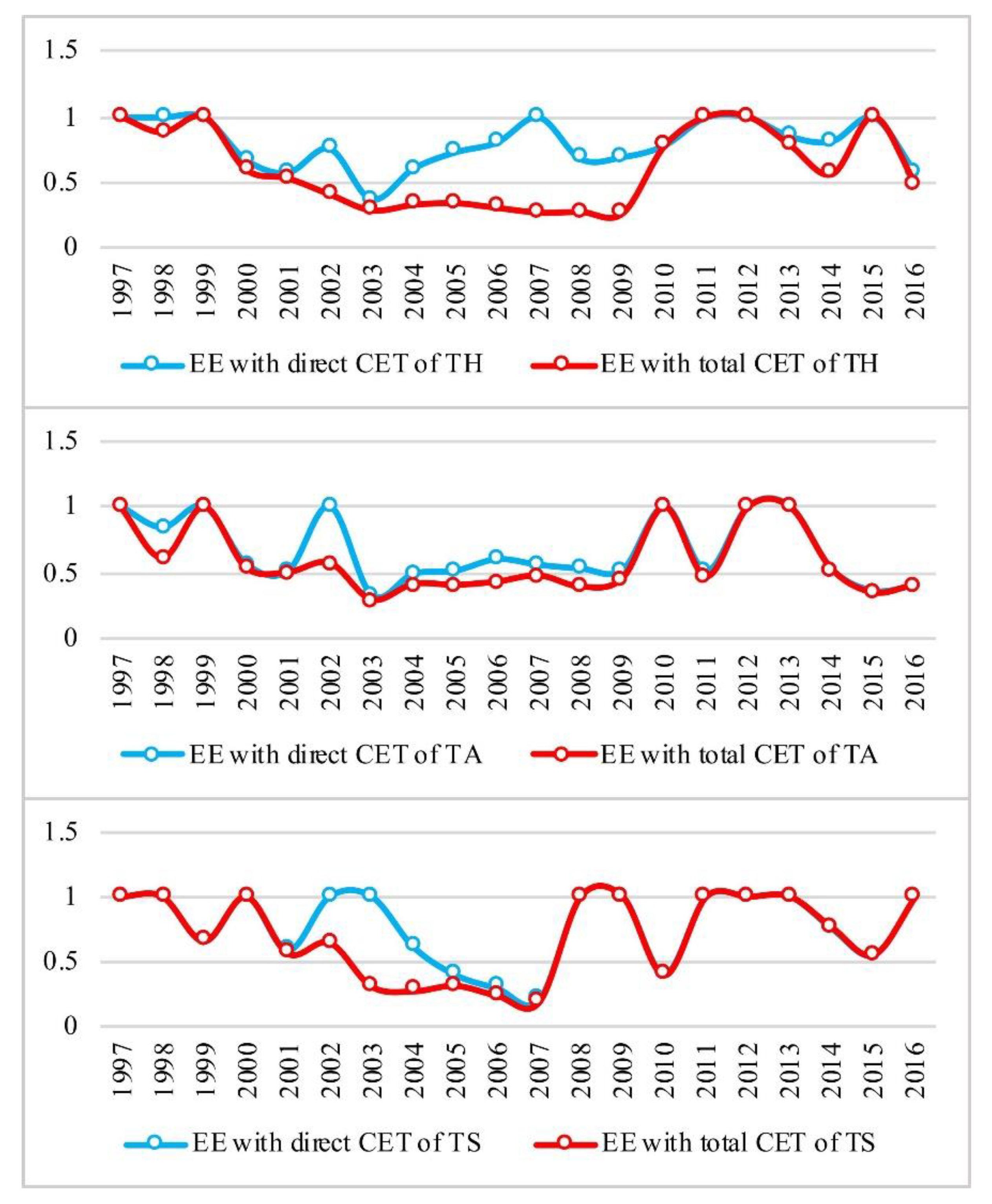
| F | Intermediate Use | |||||||
|---|---|---|---|---|---|---|---|---|
| Industrial Sector | S1 | … | Sj | … | Sn | Final Use | Total Output | |
| Intermediate input | IS1 | … | … | |||||
| ⋮ | ⋮ | ⋮ | ⋮ | … | … | |||
| ISi | … | … | ||||||
| ⋮ | ⋮ | ⋮ | ⋮ | … | … | |||
| ISn | … | … | ||||||
| Value added | … | … | ||||||
| Total input | … | … | ||||||
| Indicator | Data Source | Unit | |
|---|---|---|---|
| Input | Number of employees | Yearbook of China Tourism Statistics | Count |
| Original cost of fixed assets | Yearbook of China Tourism Statistics | 10,000 Yuan | |
| Output | Operating revenue | Yearbook of China Tourism Statistics | 10,000 Yuan |
| Undesirable output | Direct carbon emissions/Total carbon emissions | Calculation | 10,000 tons |
| Variable | Mean | Standard Deviation | Minimum | Maximum |
|---|---|---|---|---|
| HDE | 0.7936 | 0.1882 | 0.3619 | 1.0000 |
| HTE | 0.6014 | 0.2972 | 0.2581 | 1.0000 |
| HS | 0.5755 | 0.0990 | 0.3243 | 0.8449 |
| HEI | 0.3139 | 0.0561 | 0.2464 | 0.4089 |
| lnHTI | 11.5222 | 0.5330 | 10.4293 | 12.1225 |
| lnHTP | 9.8961 | 0.5825 | 8.7744 | 10.4335 |
| lnHRI | 1.1084 | 0.3276 | 0.0000 | 1.5056 |
| TDE | 0.6592 | 0.2500 | 0.3227 | 1.0000 |
| TTE | 0.5870 | 0.2556 | 0.2835 | 1.0000 |
| TS | 0.2691 | 0.0631 | 0.0873 | 0.3545 |
| TEI | 0.2310 | 0.0419 | 0.1704 | 0.3016 |
| lnTTI | 10.7397 | 0.5922 | 9.5321 | 11.5509 |
| lnTTP | 13.3644 | 0.5396 | 12.1093 | 14.1544 |
| TRI | 0.9485 | 1.2501 | 0.0680 | 6.0133 |
| SDE | 0.7771 | 0.2777 | 0.2175 | 1.0000 |
| STE | 0.6993 | 0.3128 | 0.1977 | 1.0000 |
| SS | 0.1554 | 0.0981 | 0.0536 | 0.4709 |
| SEI | 0.2310 | 0.0419 | 0.1704 | 0.3016 |
| lnSTI | 10.0833 | 0.9741 | 8.6770 | 12.3838 |
| lnSTP | 16.3363 | 1.2287 | 14.6281 | 18.3264 |
| SRI | 3.2302 | 2.0131 | 0.5775 | 8.1709 |
| lnPGDP | 9.0238 | 0.6053 | 8.0706 | 9.8162 |
| THI | 0.4075 | 0.0417 | 0.3347 | 0.5141 |
| UR | 0.3177 | 0.0789 | 0.1839 | 0.4467 |
| lnED | 3.0698 | 0.7644 | 1.6233 | 3.8225 |
| lnRO | 1.9817 | 0.5917 | 1.2698 | 2.6603 |
| lnFR | 8.1080 | 0.7943 | 5.4972 | 8.9434 |
| Model 1 | Model 2 | Model 3 | Model 4 | Model 5 | Model 6 | |||||||
|---|---|---|---|---|---|---|---|---|---|---|---|---|
| Coef. | t | Coef. | t | Coef. | t | Coef. | t | Coef. | t | Coef. | t | |
| HS | 0.8167 | 1.46 | 1.5175 | 2.2 * | ||||||||
| D1.lnHTI | 1.7599 | 3.69 *** | 1.8436 | 2.92 ** | ||||||||
| D1.lnHTP | −1.2001 | −2.77 ** | −1.3645 | −2.27 * | ||||||||
| D1.HEI | −3.3593 | −4.48 *** | −1.5378 | −1.67 | ||||||||
| D1.lnHRI | 1.6817 | 3.44 ** | 1.3837 | 2.43 ** | ||||||||
| TS | −3.1697 | −2.21 * | −2.2856 | −2.7 ** | ||||||||
| D1.lnTTI | −0.2767 | -1.3 | −0.2821 | −1.47 | ||||||||
| lnTTP | 0.7395 | 1.43 | 0.7499 | 1.78 | ||||||||
| TEI | −5.2951 | −2.62 ** | −3.3253 | −2.12 * | ||||||||
| TRI | −0.0118 | −0.25 | −0.0050 | −0.13 | ||||||||
| SS | 16.0436 | 3.26 ** | 2.9920 | 2.39 ** | ||||||||
| D1.lnSTI | −7.7122 | −3.49 ** | −1.3180 | −2.62 ** | ||||||||
| D1.lnSTP | 3.7003 | 3.41 ** | 0.7931 | 2.23 * | ||||||||
| SEI | −81.4394 | −3.34 ** | −9.3551 | −2.45 ** | ||||||||
| SRI | 0.4058 | −4.65 *** | −0.0834 | −1.72 | ||||||||
| D2.lnpgdp | −1.2876 | −1.65 | 0.5526 | 0.58 | 2.2572 | 1.2 | 0.9559 | 0.75 | 18.9987 | 3.22 ** | −0.6318 | −0.42 |
| D1.thirdi | −2.5387 | −0.77 | −0.7067 | −0.18 | −7.1938 | −1.65 | −8.7556 | −2.89 ** | 40.0462 | 3 ** | −2.4897 | −0.43 |
| D1.urban | 15.1017 | 1.68 | 15.4329 | 1.04 | −3.4939 | −0.24 | 5.2261 | 0.43 | −115.4852 | −2.57 ** | 14.4444 | 0.82 |
| lnedu | 0.0667 | 0.49 | −0.6814 | −3.6 *** | −1.1568 | −2.63 ** | −1.0686 | −3.49 ** | −9.7988 | −3.17 ** | −1.3673 | −2.26 * |
| D1.lnroad | 0.1216 | 0.7 | 0.1952 | 0.85 | −0.3837 | −1.38 | −0.2979 | −1.18 | 1.8133 | 3.5 ** | 0.4618 | 1.14 |
| lnfr | 0.3104 | 1.83 | 1.1500 | 5.47 *** | 0.7369 | 0.98 | 0.8118 | 1.52 | 8.1213 | 3.06 ** | 1.5389 | 2.36 * |
| _cons | −2.7007 | −1.94 * | −7.8254 | −4.84 *** | −9.4326 | −2.44** | −11.3842 | −3.42 ** | −14.0173 | −2.25* | −5.7348 | −1.96 * |
| Log likelihood | 7.8004 | 6.0796 | 4.7628 | 7.3352 | 3.5624 | −1.8279 | ||||||
Publisher’s Note: MDPI stays neutral with regard to jurisdictional claims in published maps and institutional affiliations. |
© 2022 by the authors. Licensee MDPI, Basel, Switzerland. This article is an open access article distributed under the terms and conditions of the Creative Commons Attribution (CC BY) license (https://creativecommons.org/licenses/by/4.0/).
Share and Cite
Xia, B.; Dong, S.; Li, Z.; Zhao, M.; Sun, D.; Zhang, W.; Li, Y. Eco-Efficiency and Its Drivers in Tourism Sectors with Respect to Carbon Emissions from the Supply Chain: An Integrated EEIO and DEA Approach. Int. J. Environ. Res. Public Health 2022, 19, 6951. https://doi.org/10.3390/ijerph19116951
Xia B, Dong S, Li Z, Zhao M, Sun D, Zhang W, Li Y. Eco-Efficiency and Its Drivers in Tourism Sectors with Respect to Carbon Emissions from the Supply Chain: An Integrated EEIO and DEA Approach. International Journal of Environmental Research and Public Health. 2022; 19(11):6951. https://doi.org/10.3390/ijerph19116951
Chicago/Turabian StyleXia, Bing, Suocheng Dong, Zehong Li, Minyan Zhao, Dongqi Sun, Wenbiao Zhang, and Yu Li. 2022. "Eco-Efficiency and Its Drivers in Tourism Sectors with Respect to Carbon Emissions from the Supply Chain: An Integrated EEIO and DEA Approach" International Journal of Environmental Research and Public Health 19, no. 11: 6951. https://doi.org/10.3390/ijerph19116951
APA StyleXia, B., Dong, S., Li, Z., Zhao, M., Sun, D., Zhang, W., & Li, Y. (2022). Eco-Efficiency and Its Drivers in Tourism Sectors with Respect to Carbon Emissions from the Supply Chain: An Integrated EEIO and DEA Approach. International Journal of Environmental Research and Public Health, 19(11), 6951. https://doi.org/10.3390/ijerph19116951









